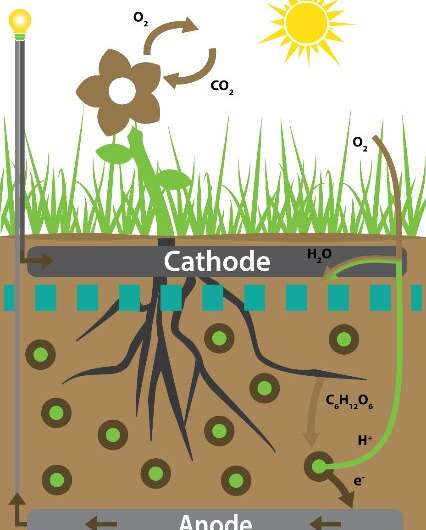Plant-powered sensor sends signal to space

A device that uses electricity generated by plants as its power source has communicated via satellite—a world first.
Such sensors could be used to connect everyday objects in remote locations, enabling them to send and receive data as part of the Internet of Things.
The device can inform farmers about the conditions of their crops to help increase yield, and enable retailers to gain detailed information about potential harvests.
It transmits data on air humidity, soil moisture and temperature, enabling field-by-field reporting from agricultural land, rice fields or other aquatic environments.
The extremely low power device sends signals at radio frequencies that are picked up by satellites in low Earth orbit. It was developed by Dutch company Plant-e and Lacuna Space, which is based in the Netherlands and the UK, under ESA's programme of Advanced Research in Telecommunications Systems (ARTES).
Plants produce organic matter through photosynthesis, but only part of this matter is used for plant growth. The rest is excreted into the soil through the plant's roots.
In the soil, bacteria around the roots break down this organic matter, releasing electrons as a waste product.

The technology developed by Plant-e harvests these electrons to power small electrical devices.
"This opens up a new era in sustainable satellite communications," says Rob Spurrett, chief executive and co-founder of Lacuna Space. "There are many regions in the world that are difficult to reach, which makes regular maintenance expensive and the use of solar power impossible.
"Through this technology, we can help people, communities and companies in those regions to improve their lives and businesses."
Marjolein Helder, chief executive of Plant-e, says: "This collaboration shows how effective plant-electricity already is at its current state of development. We hope this inspires others to consider plant electricity as a serious option."
Frank Zeppenfeldt, who works on future satellite communication systems at ESA, says: "We are very enthusiastic about this demonstration that combines biotechnology and space technology.
"A number of new opportunities for satellite-based Internet-of-Things will be enabled by this. It will help to collect small data points in agricultural, logistic, maritime and transportation applications—where terrestrial connectivity is not always available."
Provided by European Space Agency




















